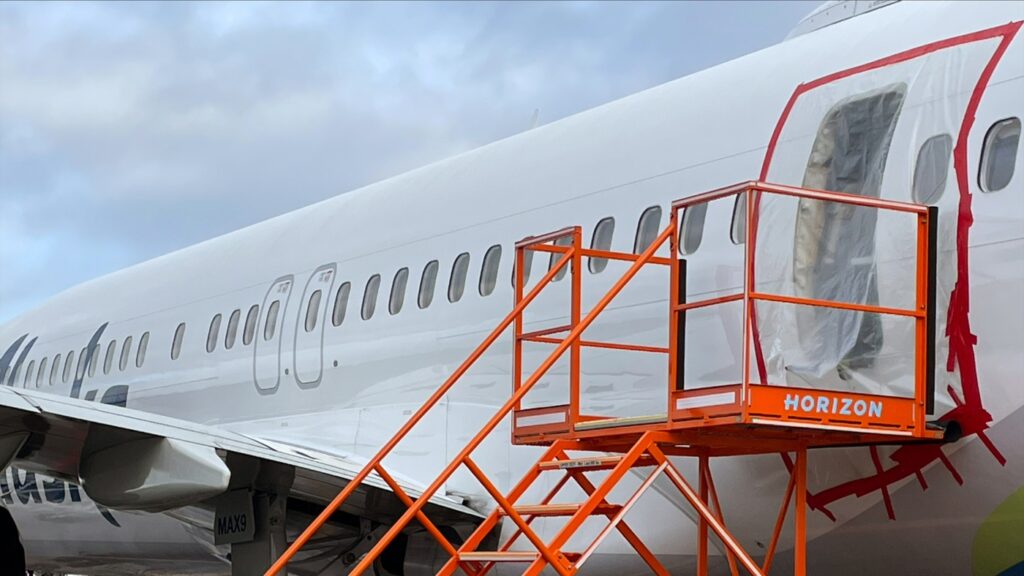
PORTLAND, OREGON - JANUARY 7: In this National Transportation Safety Board (NTSB) handout, plastic covers the exterior of the fuselage plug area of Alaska Airlines Flight 1282 Boeing 737-9 MAX on January 7, 2024 in Portland, Oregon. A door-sized section near the rear of the Boeing 737-9 MAX plane blew off 10 minutes after Alaska Airlines Flight 1282 took off from Portland, Oregon on January 5 on its way to Ontario, California. (Photo by NTSB via Getty Images)
WASHINGTON — The National Transportation Safety Board (NTSB) has attributed a midair blowout on a Boeing 737 Max jet to systemic safety failures, criticizing both Boeing and the Federal Aviation Administration (FAA) for inadequate safety protocols. The incident, which occurred on January 5, 2024, involved an Alaska Airlines flight where a door plug panel blew out shortly after takeoff, though all 177 passengers were safely returned to Portland International Airport.
Immediate Impact
NTSB Chair Jennifer Homendy commended the crew’s swift actions, which ensured the safety of all onboard. “This accident never should have happened,” Homendy stated, emphasizing the safety deficiencies that were apparent to both Boeing and the FAA.
Key Details Emerge
The NTSB’s investigation revealed that the door plug panel was reinstalled at Boeing’s factory without the necessary four bolts, a failure that could have been prevented with even one bolt in place. The investigation, concluded 17 months after the incident, highlighted Boeing’s lack of proper documentation and training, pointing to larger systemic issues within the company.
“Boeing relied on a single point of failure, which was a human not filing or documenting a record,” Homendy said. “That was a flaw in the system.”
Industry Response
The incident prompted significant changes at Boeing, including the resignation of former CEO Dave Calhoun and the introduction of more robust training programs. Current CEO Kelly Ortberg has been credited with refocusing the company on safety.
“We at Boeing regret this accident and continue to work on strengthening safety and quality across our operations,” Boeing stated. “We will review the final report and recommendations as we continue to implement improvements.”
By the Numbers
- 177 passengers safely returned to Portland International Airport
- 4 bolts missing from the door plug panel
- 38 jets per month production cap imposed by the FAA
What Comes Next
The FAA has increased its oversight of Boeing’s Renton, Washington factory, where the 737 Max jets are built, temporarily capping production at 38 planes per month. The agency has committed to maintaining this cap until it is confident in Boeing’s ability to uphold safety and quality standards.
“The FAA has fundamentally changed how it oversees Boeing since the Alaska Airlines door-plug accident and we will continue this aggressive oversight,” the agency stated.
Background Context
The incident is a setback for Boeing, which has been working to rebuild trust following two fatal 737 Max crashes in 2018 and 2019. The Department of Justice recently reached an agreement in principle with Boeing to drop a criminal case related to those crashes, despite objections from victims’ families.
“Frankly, it’s nothing short of a miracle that no one died,” Homendy remarked about the Alaska Airlines incident.
Expert Analysis
Industry experts suggest that the changes implemented by Boeing and the FAA could lead to improved safety standards across the aerospace sector. However, they warn that ongoing vigilance is necessary to prevent future incidents.
As Boeing continues to navigate these challenges, the focus remains on ensuring that such systemic failures are addressed to restore confidence among regulators and the flying public.






